Optimizing Integration of Fuel Cell Technology in Renewable Energy-Based Microgrids for Sustainable and Cost-Effective Energy
Abstract
:1. Introduction
- A hybrid system configuration incorporating solar PV/battery energy storage and solar PV/fuel cell based methods is presented in this manuscript for an optimal hybrid system configuration.
- The optimization model presented in this article is used to accomplish a case study in Patiala.
- An altitude of 257 m places Patiala in southeastern Punjab, northwestern India at a position of 30.3398° N, 76.3869° E.
- The purpose of the paper is to minimize the total life cycle costs (TLCC).
- The TLCC is calculated by considering the cost of generation, installation, and operation of the system.
- The results show that the optimal hybrid system configuration can reduce the total cost as compared to the standalone solar PV system.
2. System Description
- Load Profile Data: As can be seen from Table 1, the baseline and scaled load on a daily basis has an average value of 175.47 kWh, the average (kW) load level with a scaled load level of 7.3 kW, the peak capacity load level with a scaled load level of 25.47 kW, and the load factor for the baseline, and scaled load level at 0.5 is assumed. Based on the annual load data presented in Table 2 and Table 3, the weekday and weekend loads are calculated.
- Battery Bank: The conventional approach to storing electrical energy is to use a battery bank. Assembling one or more batteries in order to store energy electrochemically is also considered electrochemical storage [9]. Using HOMER software, a battery is modelled as an energy storage system that can store a specified amount of direct current (DC) with a fixed energy efficiency round-trip. It determines whether a battery needs to be replaced based on the number of charge and discharge cycles [10]. The battery system can be used in various applications such as energy storage in renewable energy systems, power-grid support, uninterruptible power supply, and others. It is important to note that batteries have a finite lifespan and, thus, need to be replaced at regular intervals. To ensure batteries are replaced on time, a battery system can be used to monitor their condition. This system can also be used to alert when the battery needs to be replaced. Additionally, the system can be used to optimize battery performance. Table 4 represents the battery description which is used in the proposed model.
- Solar PV Panel: Electricity is generated by solar panels by absorbing sunlight. However, there are certain variables that affect the PV’s output, such as temperature and sunlight. Solar panel output is also affected by shading, dust, and dirt. To maximize the output, it is important to install the panels in a location that receives direct sunlight and is not affected by shade. Regularly cleaning the panels can help maintain their efficiency. Panels should also be angled correctly to maximize the amount of sunlight received. Additionally, panels should be installed in areas with low temperatures to ensure optimal performance.
- Fuel Cell: An electro-chemical device that converts chemical energy into electrical energy is called a fuel cell (FC). Fuel cells are available in a variety of configurations based on the types of electrodes, operating characteristics, and power ranges they operate at. Fuel cells can be used to generate power for a wide range of applications from home heating and cooling systems to electric vehicles. Additionally, fuel cells are clean and efficient sources of energy, producing no emissions and creating no waste. Among the variety of FCs available on the market, Proton Exchange Membrane Fuel Cells (PEMFCs) are the most commonly used due to their excellent start-up time and low operating temperature. PEMFCs are also known for their high energy efficiency and low emissions, making them an ideal choice for clean energy applications. Additionally, they are relatively compact and lightweight, making them suitable for powering vehicles, portable electronics, and other applications. PEMFCs are also relatively inexpensive compared to other types of fuel cells, making them a cost-effective option for many applications. Furthermore, they are relatively low-maintenance, making them an attractive option for many users.
- Electrolyzer: Carbon-free hydrogen can be produced from renewable energy sources by electrolysis. The electrolysis process involves splitting water into hydrogen and oxygen using electricity. During this reaction, an electrolyzer is used. An electrolyzer can range in size from a small appliance that can be used to manufacture hydrogen at a small scale to a large scale, central production facility that can be connected directly to renewable or non-greenhouse gas-emitting electricity sources. The hydrogen produced by electrolysis is considered to be a clean energy source, as there are no carbon emissions generated during the production process. This makes it an attractive alternative to traditional fossil fuels. Additionally, hydrogen can be stored and used as a fuel for transportation. Furthermore, hydrogen can be produced from renewable sources such as solar, wind, and water, making it an even greener option. Hydrogen also has a high energy density and can be used in stationary power plants.
- Hydrogen Storage Tank: Hydrogen is stored in hydrogen tanks and supplied to fuel cells for energy generation after it is produced by the electrolyzer [11]. During a day, hydrogen is produced by the electrolyzer and stored in the hydrogen tank, which is used when there is no PV generation. The stored hydrogen is then used as a source of renewable energy, which is converted into electrical energy by the fuel cell. This electrical energy can then be used to power the electric vehicle or stored in the battery for later use.
2.1. Methodology
2.2. System Modelling
- Solar PV Model: Based on Equation (1), a solar PV panel’s power output (depends on solar radiation) is proportional to the amount of sunlight it receives.
- Battery Bank: During times when the power from renewable systems is insufficient or absent, a battery is used to store excess energy. An accurate estimation of the state of charge (SOC) can lead to the measurement of energy. Equation (3) can be used to calculate the SOC of a battery:
- Fuel Cell: In hydrogen fuel cells, chemical energy is converted directly into electric power, while at the same time, heat and water are produced as by-products as long as fuel is available. Hydrogen fuel cells are considered to be a clean and renewable source of energy, as they do not emit any greenhouse gases [13]. They are also highly efficient, with some fuel cells achieving up to 80% efficiency. The anode and cathode chemical reactions are shown in equations 8 to 10. By combining reactions on both electrodes, the entire reaction may be obtained.
- Electrolyzer: The electrolyzer converts the surplus electricity from the PV panels into hydrogen, which is stored in a hydrogen tank and used to power the fuel cell. Hydrogen production by the electrolyzer is the primary aspect to consider. Equation (15) shows the mass flow rate of hydrogen produced by a 1 kW electrolyzer in kilograms per hour:
- Hydrogen Tank: The electrolyzer produces hydrogen that is stored in hydrogen tanks for use in fuel cells. As the electrolyzer produces hydrogen during the day, the hydrogen tank stores it, as well as supplying hydrogen to the fuel cell when no PV power is generated. A decision variable for the proposed system was the size of the hydrogen tank, in kilograms. t is , the time at which hydrogen is available to flow. As shown in Equation (16), hydrogen is available at a given time after being produced by the electrolyzer.
2.3. Proposed Algorithm
2.3.1. Rat Search Algorithm (RSA)
- Mathematical Modeling:
| Algorithm 1 Rat search algorithm pseudo-code |
| Input: Population of rat Output: Optimal Search agent Initialize the parameter B, D, and S. Calculate the fitness value of all search agents. is the best search agent. While (x < Maxiter) do. For each search agent do. Update the position of current search agent. End for Update parameter B, D, and S. Check if there is any search agent which goes beyond the boundary condition. Calculate the fitness of each search agent. , if the solution is better than the previous one. End while , End |
2.3.2. Hybrid Particle Swarm Optimization and Rat Search Algorithm (PSORSA)
2.4. Objective Function and Constraints
3. Results and Discussion HOMER Based
4. Conclusions and Outcomes
Author Contributions
Funding
Data Availability Statement
Conflicts of Interest
References
- Ghasemi, A.; Enayatzare, M. Optimal energy management of a renewable-based isolated microgrid with pumped-storage unit and demand response. Renew. Energy 2018, 123, 460–474. [Google Scholar] [CrossRef]
- Javed, M.S.; Song, A.; Ma, T. Techno-economic assessment of a stand-alone hybrid solar-wind-battery system for a remote island using genetic algorithm. Energy 2019, 176, 704–717. [Google Scholar] [CrossRef]
- Das, M.; Singh, M.A.K.; Biswas, A. Techno-economic optimization of an off-grid hybrid renewable energy system using metaheuristic optimization approaches–case of a radio transmitter station in India. Energy Convers. Manag. 2019, 185, 339–352. [Google Scholar] [CrossRef]
- Mokhtara, C.; Negrou, B.; Settou, N.; Bouferrouk, A.; Yao, Y. Design optimization of grid-connected PV-Hydrogen for energy prosumers considering sector-coupling paradigm: Case study of a university building in Algeria. Int. J. Hydrogen Energy 2021, 46, 37564–37582. [Google Scholar] [CrossRef]
- Yu, X.; Li, W.; Maleki, A.; Rosen, M.A.; Birjandi, A.K.; Tang, L. Selection of optimal location and design of a stand-alone photovoltaic scheme using a modified hybrid methodology. Sustain. Energy Technol. Assess. 2021, 45, 101071. [Google Scholar] [CrossRef]
- Sawle, Y.; Gupta, S.C.; Kumar Bohre, A. PV-wind hybrid system: A review with case study. Cogent Eng. 2016, 3, 1189305. [Google Scholar] [CrossRef]
- Mahato, D.P.; Sandhu, J.K.; Singh, N.P.; Kaushal, V. On scheduling transaction in grid computing using cuckoo search-ant colony optimization considering load. Clust. Comput. 2020, 23, 1483–1504. [Google Scholar] [CrossRef]
- Rani, S.; Babbar, H.; Kaur, P.; Alshehri, M.D.; Shah, S.H.A. An optimized approach of dynamic target nodes in wireless sensor network using bio inspired algorithms for maritime rescue. IEEE Trans. Intell. Transp. Syst. 2022, 24, 2548–2555. [Google Scholar] [CrossRef]
- Hina, F.; Prabaharan, N.; Palanisamy, K.; Akhtar, K.; Saad, M.; Jackson, J.J. Hybrid-Renewable Energy Systems in Microgrids; Woodhead Publishing: Cambridge, UK, 2018. [Google Scholar]
- Lambert, T.; Gilman, P.; Lilienthal, P. Micropower system modeling with HOMER. Integr. Altern. Sources Energy 2006, 1, 379–385. [Google Scholar]
- Singh, S.; Chauhan, P.; Aftab, M.A.; Ali, I.; Hussain, S.S.; Ustun, T.S. Cost optimization of a stand-alone hybrid energy system with fuel cell and PV. Energies 2020, 13, 1295. [Google Scholar] [CrossRef]
- Singh, S.; Singh, M.; Kaushik, S.C. Feasibility study of an islanded microgrid in rural area consisting of PV, wind, biomass and battery energy storage system. Energy Convers. Manag. 2016, 128, 178–190. [Google Scholar] [CrossRef]
- Hemi, H.; Ghouili, J.; Cheriti, A. A real time fuzzy logic power management strategy for a fuel cell vehicle. Energy Convers. Manag. 2014, 80, 63–70. [Google Scholar] [CrossRef]
- Wu, K.; Zhou, H.; An, S.; Huang, T. Optimal coordinate operation control for wind–photovoltaic–battery storage power-generation units. Energy Convers. Manag. 2015, 90, 466–475. [Google Scholar] [CrossRef]
- Nehrir, M.H.; Wang, C.; Strunz, K.; Aki, H.; Ramakumar, R.; Bing, J.; Miao, Z.; Salameh, Z. A review of hybrid renewable/alternative energy systems for electric power generation: Configurations, control, and applications. IEEE Trans. Sustain. Energy 2011, 2, 392–403. [Google Scholar] [CrossRef]
- Nijhawan, P.; Singla, M.K.; Gupta, J. A proposed hybrid model for electric power generation: A case study of Rajasthan, India. IETE J. Res. 2021, 69, 1952–1962. [Google Scholar] [CrossRef]
- Nijhawan, P.; Singla, M.K.; Gupta, J. Site selection of solar PV power plant at Bathinda. Int. J. Recent Technol. Eng. 2020, 8, 5032–5038. [Google Scholar] [CrossRef]

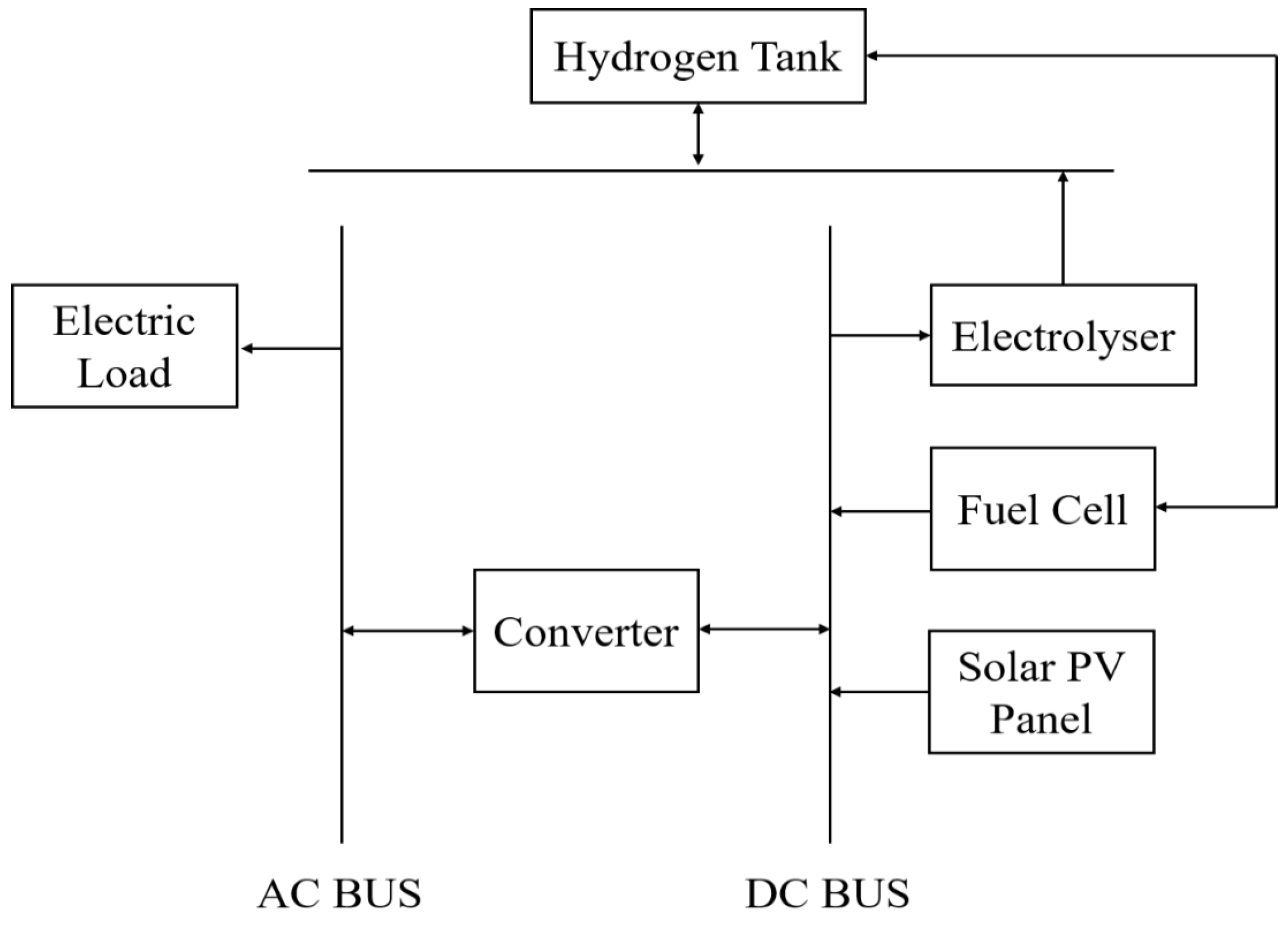
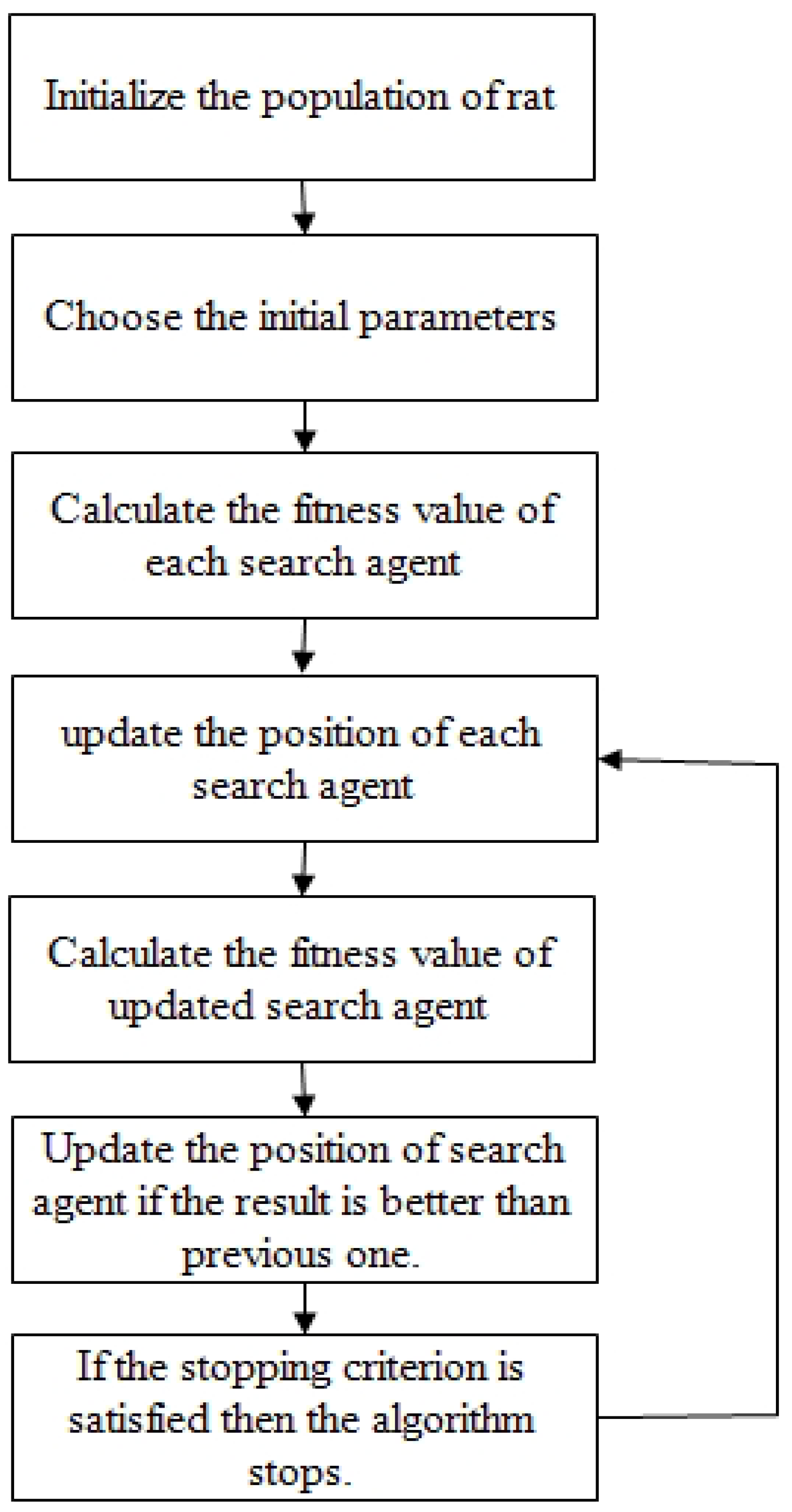

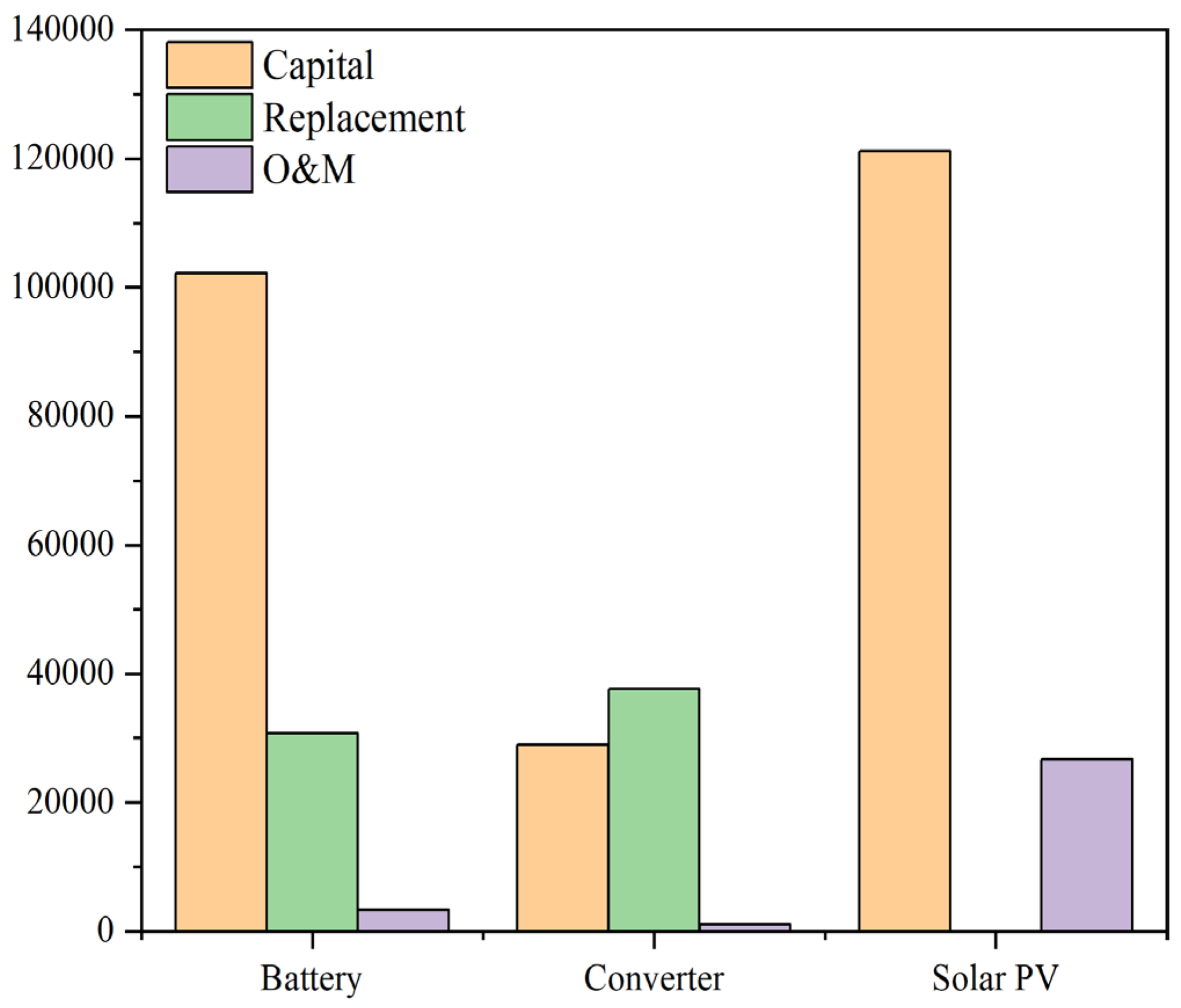
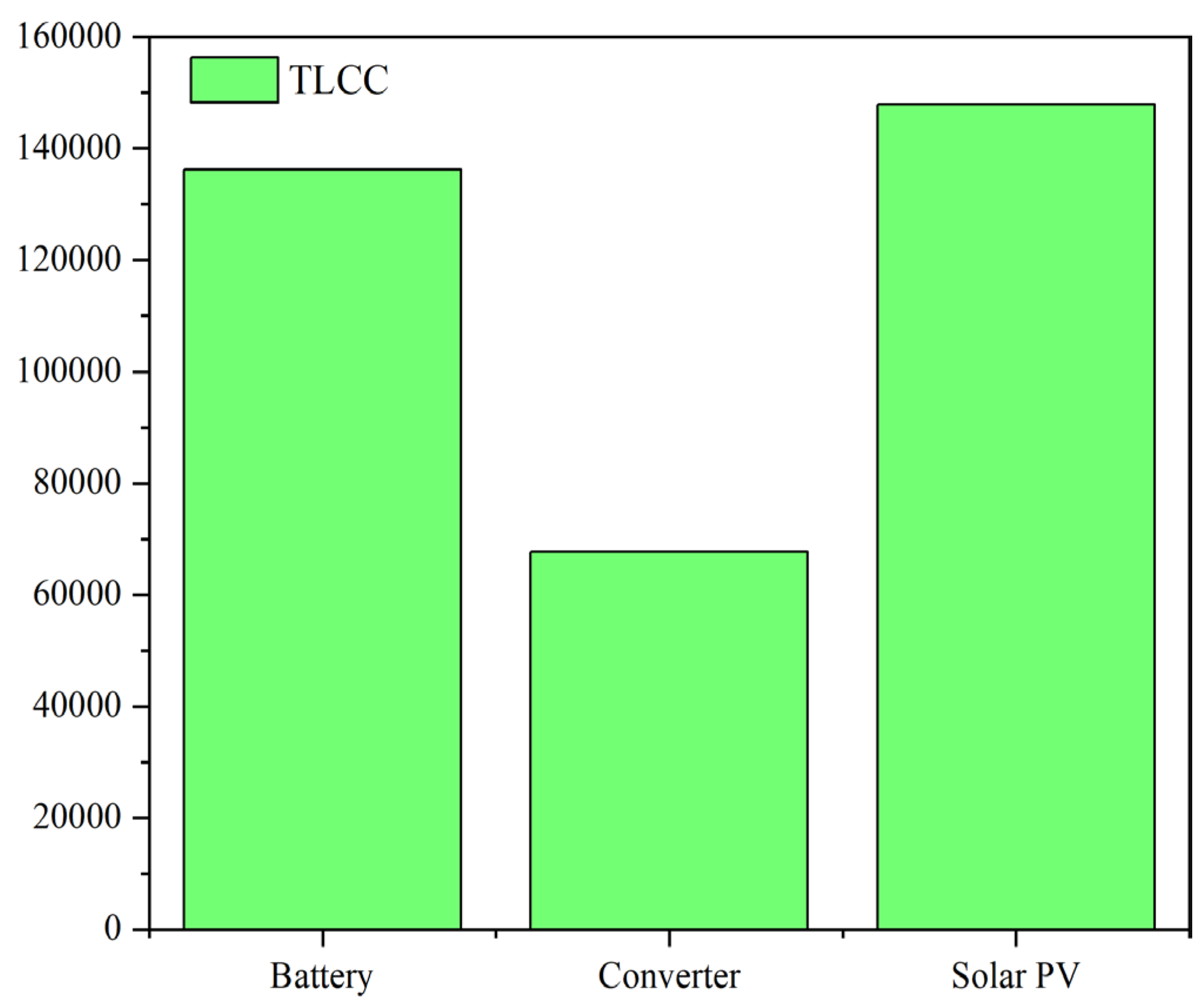
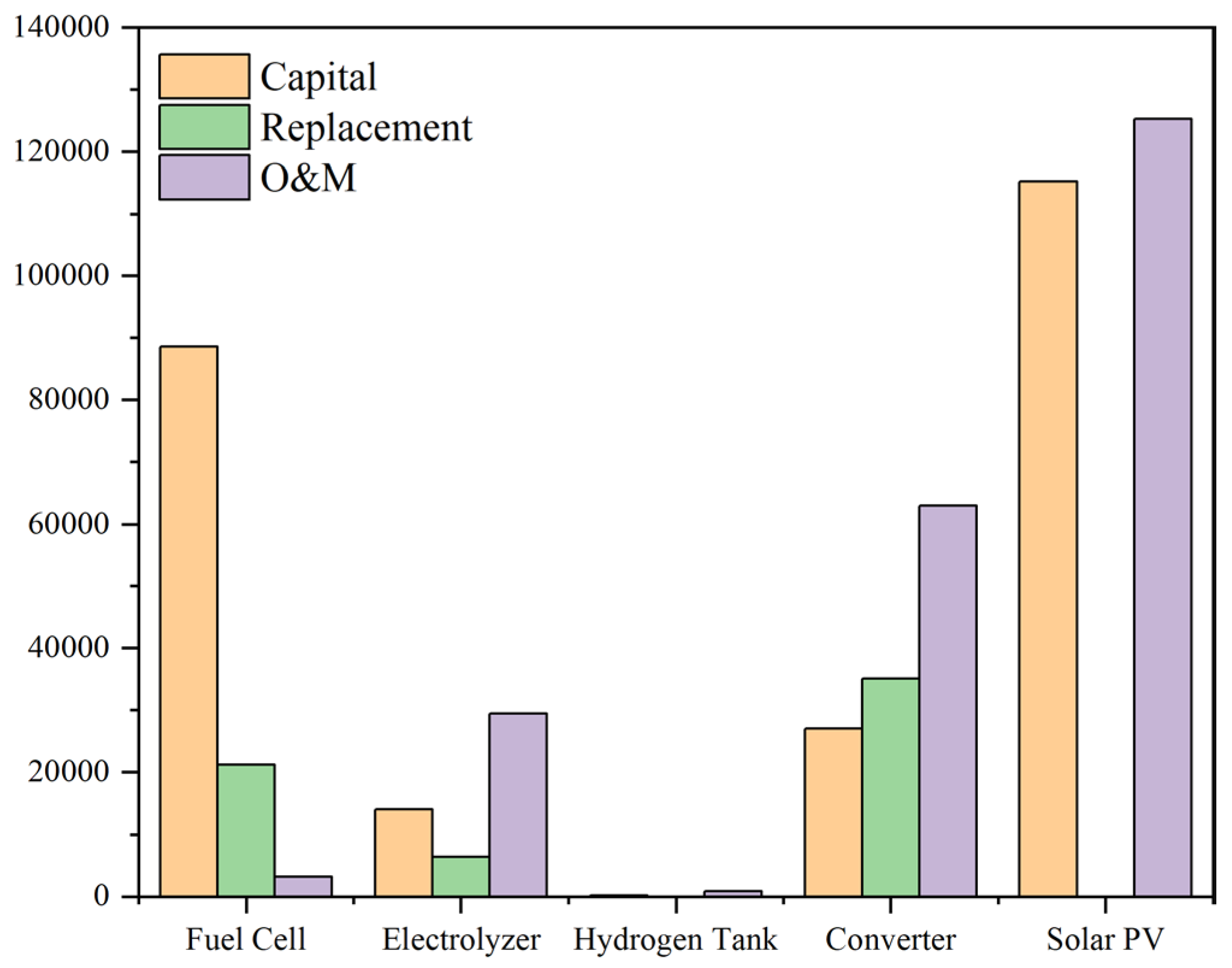
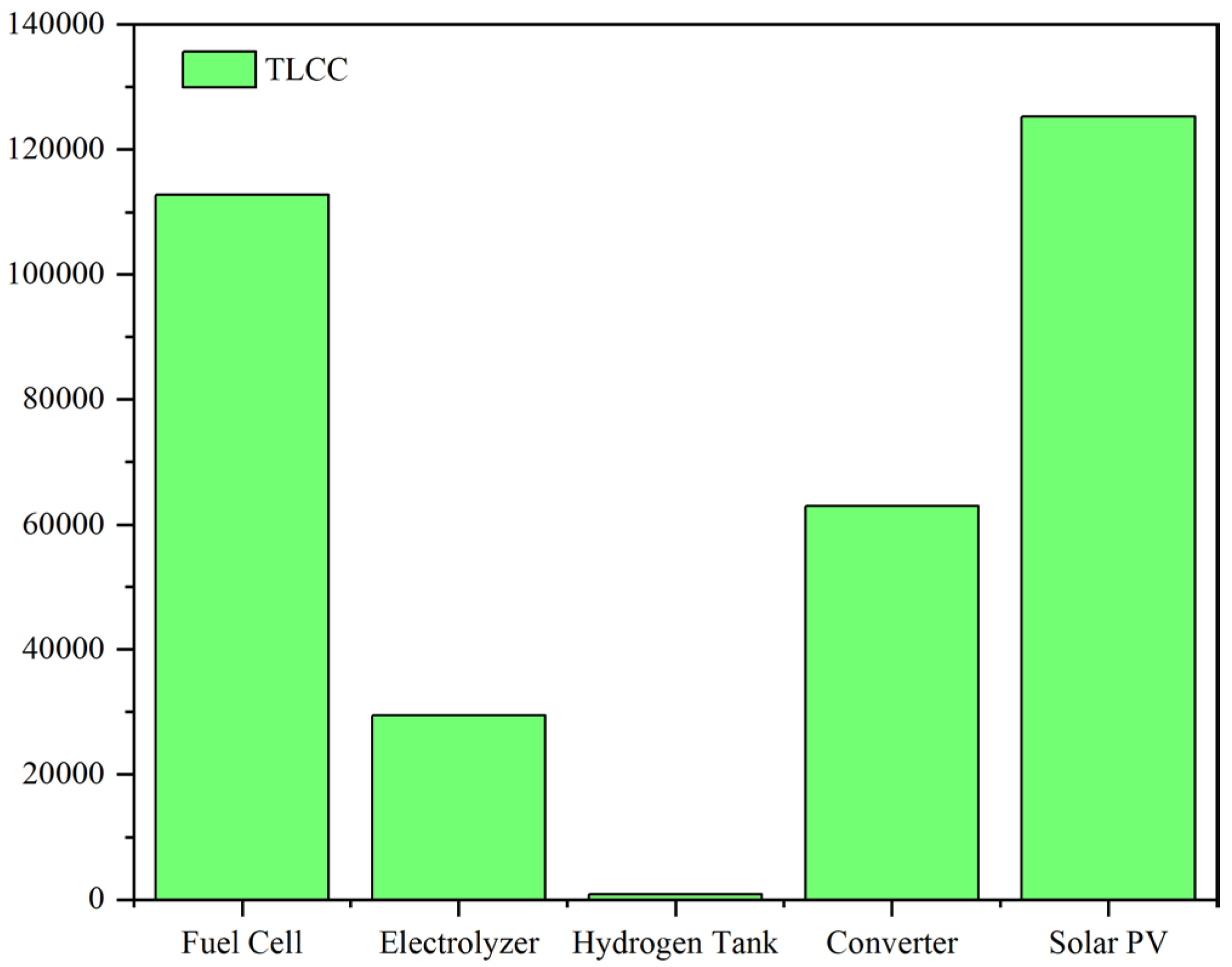
| Parameters | Baseline Load | Scaled Load |
|---|---|---|
| Average (kWh/day) | 175.47 | 175.47 |
| Average (kW) | 7.3 | 7.3 |
| Peak (kW) | 25.47 | 25.47 |
| Load Factor | 0.5 | 0.5 |
| Hour | Jan | Feb | Mar | Apr | May | Jun | Jul | Aug | Sep | Oct | Nov | Dec |
|---|---|---|---|---|---|---|---|---|---|---|---|---|
| 0 | 0.109 | 0.109 | 0.109 | 0.109 | 0.109 | 0.109 | 0.109 | 0.109 | 0.109 | 0.109 | 0.109 | 0.109 |
| 1 | 0.095 | 0.095 | 0.095 | 0.095 | 0.095 | 0.095 | 0.095 | 0.095 | 0.095 | 0.095 | 0.095 | 0.095 |
| 2 | 0.095 | 0.095 | 0.095 | 0.095 | 0.095 | 0.095 | 0.095 | 0.095 | 0.095 | 0.095 | 0.095 | 0.095 |
| 3 | 0.095 | 0.095 | 0.095 | 0.095 | 0.095 | 0.095 | 0.095 | 0.095 | 0.095 | 0.095 | 0.095 | 0.095 |
| 4 | 0.327 | 0.327 | 0.327 | 0.327 | 0.327 | 0.327 | 0.327 | 0.327 | 0.327 | 0.327 | 0.327 | 0.327 |
| 5 | 0.500 | 0.500 | 0.500 | 0.500 | 0.500 | 0.500 | 0.500 | 0.500 | 0.500 | 0.500 | 0.500 | 0.500 |
| 6 | 0.550 | 0.550 | 0.550 | 0.550 | 0.550 | 0.550 | 0.550 | 0.550 | 0.550 | 0.550 | 0.550 | 0.550 |
| 7 | 0.500 | 0.500 | 0.500 | 0.500 | 0.500 | 0.500 | 0.500 | 0.500 | 0.500 | 0.500 | 0.500 | 0.500 |
| 8 | 0.420 | 0.420 | 0.420 | 0.420 | 0.420 | 0.420 | 0.420 | 0.420 | 0.420 | 0.420 | 0.420 | 0.420 |
| 9 | 0.430 | 0.430 | 0.430 | 0.430 | 0.430 | 0.430 | 0.430 | 0.430 | 0.430 | 0.430 | 0.430 | 0.430 |
| 10 | 0.495 | 0.495 | 0.495 | 0.495 | 0.495 | 0.495 | 0.495 | 0.495 | 0.495 | 0.495 | 0.495 | 0.495 |
| 11 | 0.533 | 0.533 | 0.533 | 0.533 | 0.533 | 0.533 | 0.533 | 0.533 | 0.533 | 0.533 | 0.533 | 0.533 |
| 12 | 0.691 | 0.691 | 0.691 | 0.691 | 0.691 | 0.691 | 0.691 | 0.691 | 0.691 | 0.691 | 0.691 | 0.691 |
| 13 | 0.519 | 0.519 | 0.519 | 0.519 | 0.519 | 0.519 | 0.519 | 0.519 | 0.519 | 0.519 | 0.519 | 0.519 |
| 14 | 0.418 | 0.418 | 0.418 | 0.418 | 0.418 | 0.418 | 0.418 | 0.418 | 0.418 | 0.418 | 0.418 | 0.418 |
| 15 | 0.397 | 0.397 | 0.397 | 0.397 | 0.397 | 0.397 | 0.397 | 0.397 | 0.397 | 0.397 | 0.397 | 0.397 |
| 16 | 0.409 | 0.409 | 0.409 | 0.409 | 0.409 | 0.409 | 0.409 | 0.409 | 0.409 | 0.409 | 0.409 | 0.409 |
| 17 | 0.658 | 0.658 | 0.658 | 0.658 | 0.658 | 0.658 | 0.658 | 0.658 | 0.658 | 0.658 | 0.658 | 0.658 |
| 18 | 1.231 | 1.231 | 1.231 | 1.231 | 1.231 | 1.231 | 1.231 | 1.231 | 1.231 | 1.231 | 1.231 | 1.231 |
| 19 | 1.003 | 1.003 | 1.003 | 1.003 | 1.003 | 1.003 | 1.003 | 1.003 | 1.003 | 1.003 | 1.003 | 1.003 |
| 20 | 0.676 | 0.676 | 0.676 | 0.676 | 0.676 | 0.676 | 0.676 | 0.676 | 0.676 | 0.676 | 0.676 | 0.676 |
| 21 | 0.480 | 0.480 | 0.480 | 0.480 | 0.480 | 0.480 | 0.480 | 0.480 | 0.480 | 0.480 | 0.480 | 0.480 |
| 22 | 0.300 | 0.300 | 0.300 | 0.300 | 0.300 | 0.300 | 0.300 | 0.300 | 0.300 | 0.300 | 0.300 | 0.300 |
| 23 | 0.204 | 0.204 | 0.204 | 0.204 | 0.204 | 0.204 | 0.204 | 0.204 | 0.204 | 0.204 | 0.204 | 0.204 |
| Hour | Jan | Feb | Mar | Apr | May | Jun | Jul | Aug | Sep | Oct | Nov | Dec |
|---|---|---|---|---|---|---|---|---|---|---|---|---|
| 0 | 0.109 | 0.109 | 0.109 | 0.109 | 0.109 | 0.109 | 0.109 | 0.109 | 0.109 | 0.109 | 0.109 | 0.109 |
| 1 | 0.095 | 0.095 | 0.095 | 0.095 | 0.095 | 0.095 | 0.095 | 0.095 | 0.095 | 0.095 | 0.095 | 0.095 |
| 2 | 0.095 | 0.095 | 0.095 | 0.095 | 0.095 | 0.095 | 0.095 | 0.095 | 0.095 | 0.095 | 0.095 | 0.095 |
| 3 | 0.095 | 0.095 | 0.095 | 0.095 | 0.095 | 0.095 | 0.095 | 0.095 | 0.095 | 0.095 | 0.095 | 0.095 |
| 4 | 0.327 | 0.327 | 0.327 | 0.327 | 0.327 | 0.327 | 0.327 | 0.327 | 0.327 | 0.327 | 0.327 | 0.327 |
| 5 | 0.500 | 0.500 | 0.500 | 0.500 | 0.500 | 0.500 | 0.500 | 0.500 | 0.500 | 0.500 | 0.500 | 0.500 |
| 6 | 0.550 | 0.550 | 0.550 | 0.550 | 0.550 | 0.550 | 0.550 | 0.550 | 0.550 | 0.550 | 0.550 | 0.550 |
| 7 | 0.500 | 0.500 | 0.500 | 0.500 | 0.500 | 0.500 | 0.500 | 0.500 | 0.500 | 0.500 | 0.500 | 0.500 |
| 8 | 0.462 | 0.462 | 0.462 | 0.462 | 0.462 | 0.462 | 0.462 | 0.462 | 0.462 | 0.462 | 0.462 | 0.462 |
| 9 | 0.473 | 0.473 | 0.473 | 0.473 | 0.473 | 0.473 | 0.473 | 0.473 | 0.473 | 0.473 | 0.473 | 0.473 |
| 10 | 0.545 | 0.545 | 0.545 | 0.545 | 0.545 | 0.545 | 0.545 | 0.545 | 0.545 | 0.545 | 0.545 | 0.545 |
| 11 | 0.586 | 0.586 | 0.586 | 0.586 | 0.586 | 0.586 | 0.586 | 0.586 | 0.586 | 0.586 | 0.586 | 0.586 |
| 12 | 0.760 | 0.760 | 0.760 | 0.760 | 0.760 | 0.760 | 0.760 | 0.760 | 0.760 | 0.760 | 0.760 | 0.760 |
| 13 | 0.571 | 0.571 | 0.571 | 0.571 | 0.571 | 0.571 | 0.571 | 0.571 | 0.571 | 0.571 | 0.571 | 0.571 |
| 14 | 0.460 | 0.460 | 0.460 | 0.460 | 0.460 | 0.460 | 0.460 | 0.460 | 0.460 | 0.460 | 0.460 | 0.460 |
| 15 | 0.437 | 0.437 | 0.437 | 0.437 | 0.437 | 0.437 | 0.437 | 0.437 | 0.437 | 0.437 | 0.437 | 0.437 |
| 16 | 0.450 | 0.450 | 0.450 | 0.450 | 0.450 | 0.450 | 0.450 | 0.450 | 0.450 | 0.450 | 0.450 | 0.450 |
| 17 | 0.658 | 0.658 | 0.658 | 0.658 | 0.658 | 0.658 | 0.658 | 0.658 | 0.658 | 0.658 | 0.658 | 0.658 |
| 18 | 1.231 | 1.231 | 1.231 | 1.231 | 1.231 | 1.231 | 1.231 | 1.231 | 1.231 | 1.231 | 1.231 | 1.231 |
| 19 | 1.003 | 1.003 | 1.003 | 1.003 | 1.003 | 1.003 | 1.003 | 1.003 | 1.003 | 1.003 | 1.003 | 1.003 |
| 20 | 0.676 | 0.676 | 0.676 | 0.676 | 0.676 | 0.676 | 0.676 | 0.676 | 0.676 | 0.676 | 0.676 | 0.676 |
| 21 | 0.480 | 0.480 | 0.480 | 0.480 | 0.480 | 0.480 | 0.480 | 0.480 | 0.480 | 0.480 | 0.480 | 0.480 |
| 22 | 0.300 | 0.300 | 0.300 | 0.300 | 0.300 | 0.300 | 0.300 | 0.300 | 0.300 | 0.300 | 0.300 | 0.300 |
| 23 | 0.204 | 0.204 | 0.204 | 0.204 | 0.204 | 0.204 | 0.204 | 0.204 | 0.204 | 0.204 | 0.204 | 0.204 |
| Nominal Voltage (V) | 55 |
| Nominal Capacity (kWh) | 3.26 |
| Nominal Capacity (Ah) | 63 |
| Roundtrip efficiency (%) | 94.9 |
| Maximum Charge Current (A) | 63 |
| Maximum Discharge Current (A) | 63 |
| Component | Parameter | Value | Unit |
|---|---|---|---|
| PV Panel | Maximum power (Pmax) | 100 | W |
| Maximum power voltage (Vmp) | 18 | V | |
| Maximum power current (Imp) | 5.56 | A | |
| Open circuit voltage (VOC) | 22.3 | V | |
| Short circuit voltage (IsC) | 6.1 | A | |
| Number of cells | 36 | - | |
| Nominal operating cell temperature | 45 | °C | |
| Capital cost and replacement cost | 1084 | USD/kW | |
| O&M cost | 5/kW | USD/yr | |
| Life time | 20 | yr | |
| Inverter | Rated power | 1 | kW |
| Inverter efficiency (ηinv) | 90 | % | |
| Capital and replacement cost | 127 | USD/kW | |
| O&M cost | 1 | USD/yr | |
| Life time | 20 | yr | |
| Fuel cell | Rated power | 1 | kW |
| Capital and replacement cost | 600 | USD/kW | |
| O&M cost | 0.01 | USD/h/kW | |
| Fuel cell coefficient | 0.0003 | USD/h/kW | |
| Hydrogen to electricity conversion by fuel cell (QH2 | 0.059 | USD/h/kW | |
| Life time of FC | 20 | yr | |
| Electrolyzer | Capital and replacement cost | 150 | USD/kW |
| O&M cost | 8 | USD/yr/kW | |
| Efficiency | 90 | % | |
| Life time | 20 | yr | |
| Hydrogen tank | Capital cost | 1.3 | USD/kg |
| Replacement cost | 0.5 | USD/kg | |
| O&M cost | 0.6 | USD/yr/kg | |
| Life time | 20 | yr | |
| Battery | Nominal capacity | 360 | Ah |
| Nominal voltage | 6 | V | |
| Maximum charging current | 18 | A | |
| Minimum state of charge | 30 | % | |
| Maximum state of charge | 100 | % | |
| Round trip efficiency | 92 | % | |
| Capital cost | 300 | USD | |
| Replacement cost | 200 | USD | |
| O&M cost | 3.67 | USD/yr | |
| Life-time | 20 | yr | |
| Others | Project life (N) | 20 | yr |
| Interest rate (i) | 5 | % |
| Component | Capital (USD) | Replacement (USD) | O&M (USD) | TLCC (USD) |
|---|---|---|---|---|
| Battery | 102,150 | 30,750 | 3313 | 136,213 |
| Converter | 28,958 | 37,625 | 1099 | 67,682 |
| Solar PV | 121,143 | 0 | 26,741 | 147,884 |
| System | 252,251 | 68,375 | 31,153 | 351,779 |
| Algorithm | TLCC (USD) |
|---|---|
| PSO | 350,229 |
| RAT | 330,125 |
| GWO | 345,115 |
| HOMER | 351,779 |
| HHO | 343,451 |
| PSORSA | 320,224 |
| Component | Capital (USD) | Replacement (USD) | O&M (USD) | TLCC (USD) |
|---|---|---|---|---|
| Fuel Cell | 88,524 | 21,147 | 3154 | 112,825 |
| Electrolyzer | 14,000 | 6321 | 9127 | 29,448 |
| Hydrogen Tank | 140 | 0 | 750 | 890 |
| Converter | 26,989 | 35,101 | 850 | 62,940 |
| Solar PV | 115,257 | 0 | 10,012 | 125,269 |
| System | 244,910 | 62,569 | 23,893 | 331,372 |
| Algorithm | TLCC (USD) |
|---|---|
| PSO | 325,152 |
| RAT | 306,124 |
| GWO | 323,522 |
| HOMER | 331,372 |
| HHO | 318,189 |
| PSORSA | 302,198 |
Disclaimer/Publisher’s Note: The statements, opinions and data contained in all publications are solely those of the individual author(s) and contributor(s) and not of MDPI and/or the editor(s). MDPI and/or the editor(s) disclaim responsibility for any injury to people or property resulting from any ideas, methods, instructions or products referred to in the content. |
© 2023 by the authors. Licensee MDPI, Basel, Switzerland. This article is an open access article distributed under the terms and conditions of the Creative Commons Attribution (CC BY) license (https://creativecommons.org/licenses/by/4.0/).
Share and Cite
Singla, M.K.; Gupta, J.; Alsharif, M.H.; Jahid, A. Optimizing Integration of Fuel Cell Technology in Renewable Energy-Based Microgrids for Sustainable and Cost-Effective Energy. Energies 2023, 16, 4482. https://doi.org/10.3390/en16114482
Singla MK, Gupta J, Alsharif MH, Jahid A. Optimizing Integration of Fuel Cell Technology in Renewable Energy-Based Microgrids for Sustainable and Cost-Effective Energy. Energies. 2023; 16(11):4482. https://doi.org/10.3390/en16114482
Chicago/Turabian StyleSingla, Manish Kumar, Jyoti Gupta, Mohammed H. Alsharif, and Abu Jahid. 2023. "Optimizing Integration of Fuel Cell Technology in Renewable Energy-Based Microgrids for Sustainable and Cost-Effective Energy" Energies 16, no. 11: 4482. https://doi.org/10.3390/en16114482







